Diseases Related to Elevated Blood Lipids
SHTG
Severe Hypertriglyceridemia (SHTG) is caused by reduced function of, or lack of, the enzyme lipoprotein lipase (LPL). This enzyme plays a crucial role in breaking down blood triglycerides. Consequently, affected individuals can have blood triglyceride levels soaring beyond 500 mg/dL.
When these levels spike dramatically, it can trigger recurrent pancreas inflammation, known as acute pancreatitis, a condition both painful and potentially life-threatening.
Traditional drugs, such as statins, often fall short of effectively managing elevated triglyceride levels and might come with recurrent side effects. For high-risk patients, a low-fat diet frequently stands as the sole treatment recommendation. In specific cases, lipidapheresis — a procedure akin to blood dialysis — is administered at specialized clinics. However, this method is not only resource-intensive but also time-consuming, with patients often requiring multiple several hours long sessions each week, making it a costly solution.

FCS
Familial Chylomicronemia Syndrome (FCS) is a rare genetic metabolic disorder resulting from a diminished function or absence of the enzyme lipoprotein lipase (LPL). This enzyme is crucial for breaking down triglycerides in the blood. Consequently, patients with FCS experience extremely high accumulation of triglycerides in their blood.
This condition severely affects the quality of life for FCS patients. Symptoms manifest as memory lapses, hearing issues, enlargement of the liver and spleen, intense stomach pain, fat deposits in the skin, and visual complications due to effects on the retina.
A significant spike in blood triglycerides can lead to recurring inflammations in the pancreas, termed acute pancreatitis, a condition that is both painful and can be life-threatening.
Traditional drugs, such as statins, often fall short of effectively managing elevated triglyceride levels and might come with recurrent side effects. For some FCS patients, these drugs prove entirely ineffective. For high-risk patients, a low-fat diet frequently stands as the sole treatment recommendation. In specific cases, lipidapheresis — a procedure akin to blood dialysis — is administered at specialized clinics. However, this method is not only resource-intensive but also time-consuming, with patients often requiring multiple several hours long sessions each week, making it a costly solution.

Cardiovascular disease
Cardiovascular disease is a collective term for such diseases that affect the circulatory organs, the heart or the blood vessels.
Cardiovascular disease encompasses conditions affecting the heart and blood vessels. The majority of these diseases are linked to atherosclerosis, often referred to as hardening of the arteries. This condition can subsequently lead to severe events like heart attacks and strokes, both of which are major public health concerns. Another prevalent cardiovascular ailment is thromboembolism, which involves blood clots.
Today, cardiovascular disease ranks as the leading cause of death in Sweden, impacting two million individuals. On a global scale, it's estimated that one in every three deaths can be attributed to cardiovascular diseases.
Often, atherosclerosis in blood vessels may present no noticeable symptoms. As a result, a sudden heart attack or stroke could be the initial indication of an underlying condition.

Lipodystrophy
Lipodystrophy is a rare disease characterized by a partial or complete lack of fat on the body.
In the absence of normal adipose tissue, various organs begin to accumulate fat, fat begins to accumulate in various organs, causing significant metabolic complications such as extreme insulin resistance, hypertriglyceridemia (elevated blood fat triglyceride levels), and hepatic steatosis (fatty liver).
The liver plays a vital role in the body's metabolism, especially concerning fat processing. Typically, fat shouldn't remain in the liver long-term. Any excess fat should transform into lipoproteins and then be secreted into the bloodstream.
If these lipoproteins can't be broken down by the enzyme lipoprotein lipase (LPL) in muscles and fat tissue, or if the adipose tissue becomes insulin-resistant and can't store the fat, the liver may start storing fat, resulting in a fatty liver. This condition severely disrupts the liver's metabolic control.
In lipodystrophy, the absence or shortage of functional fat tissue causes the liver's metabolic functions to be inhibited by fat storage. This leads to the entire body becoming insulin-resistant, causing patients to develop type 2 diabetes and blood lipid disorders, even if they appear noticeably thin.
Immediate treatment involves fasting or restricted food intake to lessen the strain on the liver. In more severe cases, especially in older patients, liver transplantation may become essential.
While there are some treatments that alleviate lipodystrophy symptoms, none address the disease's root cause. All patients receive preventive treatment for cardiovascular diseases and diabetes. Patients with generalized lipodystrophy are given hormone supplementation (Metreleptin) which provides significant relief, yet there's no specific treatment available for those with partial lipodystrophy.

Dyslipidemia
Dyslipidemia refers to abnormal blood fat levels that persist even after conventional treatments, such as LDL-cholesterol-lowering statins. Despite achieving set treatment targets, not all cases of cardiovascular disease are currently preventable.
Patients with dyslipidemia often exhibit high blood levels of LDL, the "bad" cholesterol, or low-density lipoprotein. They may also have elevated triglycerides or reduced levels of HDL, the "good" cholesterol or high-density lipoprotein.
Diagnosis of this condition typically relies on blood tests measuring lipid amounts in the bloodstream. Most patients remain asymptomatic.
While certain dyslipidemias have a hereditary component, the risk of developing this condition generally increases with age. It's also noteworthy that dyslipidemia is more prevalent in men than women.

Type 2 diabetes
In type 2 diabetes, the body struggles to maintain low blood sugar levels. Initially, one experiences reduced glucose tolerance. This occurs because cells become less responsive to insulin, and over time, the insulin produced by the body becomes insufficient.
Being overweight or obese increases the risk of developing insulin resistance and, subsequently, type 2 diabetes.
A common blood lipid anomaly in type 2 diabetes is elevated, or significantly elevated, triglyceride levels. While "bad" LDL cholesterol levels are generally normal, some experts believe that individuals with type 2 diabetes possess smaller, denser, and more reactive LDL particles.
The most serious consequence of type 2 diabetes is the accelerated development of atherosclerosis in the arteries. This condition leads to fat, blood cells, and connective tissue deposits forming inside blood vessels, hindering blood flow. Consequently, there's an increased risk of blood clots and obstructions that can result in heart attacks or strokes. As a result, individuals with type 2 diabetes often face a reduced life expectancy.
Standard treatments involve lifestyle modifications, insulin-enhancing medications, and drugs that lower blood lipid levels.

Fatty liver
Fatty liver disease arises when the liver accumulates excessive fat. This condition is often a result of being overweight or excessive alcohol consumption, but there are hereditary causes as well. Diseases like lipodystrophy and metabolic syndrome (MBS) significantly elevate the risk of liver conditions. MBS encompasses several health-compromising disorders simultaneously: abdominal obesity, hypertension, elevated blood fats, and high blood sugar levels.
In some instances, fatty liver may lead to liver inflammation. This inflammation damages liver cells and can progress to liver cirrhosis if it persists over several years. In cirrhosis, a significant number of liver cells are lost, impairing its function.
Often, patients with fatty liver don't exhibit initial symptoms. Treatment approaches include lifestyle modifications, insulin-sensitizing medications, weight-loss surgery, and in severe cases, liver transplantation.
Blood lipid irregularities enhance the risk of cardiovascular diseases and are often addressed with statins. However, for those with liver cirrhosis, it's advisable to avoid statins.

Pancreatitis
Pancreatitis, inflammation of the pancreas, is a condition that is very painful and can be life-threatening. It requires immediate and advanced medical care. The only treatment options available today are a strict low-fat diet and lipid apheresis, a treatment similar to dialysis that removes fat from the blood.
The condition often arises as a result of high consumption of alcohol or gallstones but also of elevated values of triglycerides.
Pancreatitis can be divided into two main groups: acute pancreatitis and chronic pancreatitis. Pancreatitis is a potentially fatal disease, and approximately one-tenth of cases develop a serious inflammation with systemic effects and sometimes long-term hospitalization.
Symptoms of pancreatitis are severe abdominal pain, nausea, and fever.
